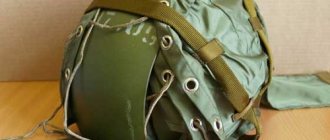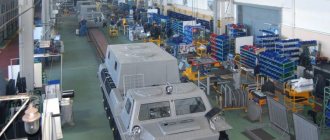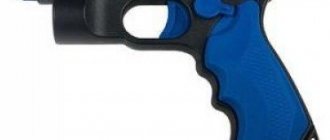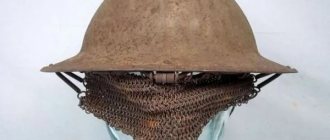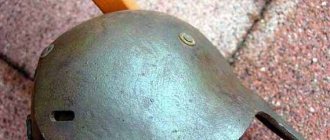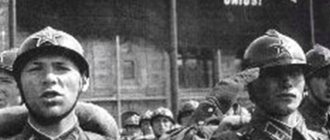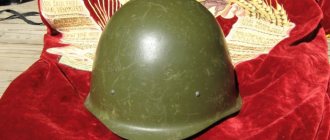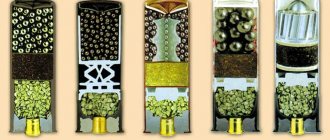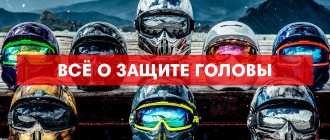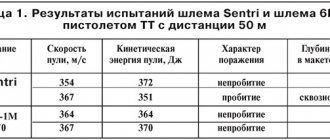Helmets in the game are a mandatory addition to torso protection, which we talked about in the previous Escape from Tarkov guide - body armor. They may not protect as effectively as breastplates, but in the case of Tarkov, any protection is always better than no protection.
The characters' heads are divided into five areas: the top of the head, the back of the head, the ears, the eyes and the jaw. A direct hit on any of them means death. The more elements of the head that are covered, the more likely players are to survive a headshot.
Headgear characteristics include durability, movement penalties, number of protected areas (most only cover the top, back of the head, and ears by default), ergonomics, and compatibility with other devices. In addition, there are indicators of sound insulation and the chance of rebound.
The first parameter affects the muffling of external sounds, and the second promises the likelihood that if a bullet hits the helmet, it will bounce off. In this case, the fighter will receive a concussion, but will not receive damage.
Second class helmets
Shockproof helmet "Cap 1" - only 25 strength points, -2% to speed, -1% to agility and has a low chance of ricochet. Sound insulation is high, compatible with K1S visor.
Fireman's helmet ShPM - has 40 durability points, low chance of ricochet, covers the back of the head, ears and top, does not penalize running speed, reduces turning speed by 12% . The visor is not removable.
Helmet PSH-97 “Jeta” 65 points of armor available -13% for turning.
Armored helmet (protective helmet)
An armored helmet (BS) is designed to protect a person’s head, face and neck from damage from ammunition fragments, small arms bullets, cold steel, as well as from impacts and dynamic impacts during combat operations.
The armored helmet protects against bullets from PM pistols of 9.0 mm caliber, pistols of 6.35 and 5.6 mm caliber, and a TT pistol of 7.62 mm caliber, from a distance of 5 meters. the above mentioned means of destruction up to the 2nd degree. Increasing the bullet resistance of a helmet leads to an increase in its weight, and according to experts, an increase in weight of more than 1.5 kg reduces maneuverability. According to Russian legislation, all armored helmets must be certified according to GOST R 50744-95. In recent years, armored helmets, as personal armor protection (PIB), have begun to be actively used not only by law enforcement and army structures, but also by private security organizations when collecting material assets and in rapid response groups. Structurally, an armored helmet consists of:
- a body, made, as a rule, in the form of a single armored element (helmet), repeating the outline of the protected areas of the head,
— a damper placed between the body and the head, which serves to improve ergonomics, shock absorption and reduce the blocking effect in case of ballistic damage,
- removable balaclava,
— internal equipment.
Additionally, armored products can be equipped with: - a transparent bulletproof visor for face protection; — aventail to protect the neck; — built-in radio headset for communication; — fabric cover and hard container for transportation and storage.
The internal equipment of the helmet is designed to stay on the head and absorb the dynamic impact of a bullet and fragments on a person’s head. It consists of a fixing system, straps (behind the neck, chin), tension regulators.
The body armor element is made in the form of a one-piece pressed (one-piece stamped) base made of plastic reinforced with high-strength fibers (aramid, high-modulus polyethylene, etc.) or metal (alloy steel and titanium alloys).
Currently, 4 main types of armored helmets are used in Russia: - metal ones made of thin sheet steel; - composite; — aramid-fabric; - combined.
The most optimal materials for armored helmets are considered to be composite and combined metal-composite or composite-ceramic, as well as materials based on organic fibers (nylon, aramids). With minimal weight, such helmets are highly resistant to impact loads, protect against 70-80% of fragments flying at speeds of up to 500 m/s, absorb bullet energy well, and are also the most comfortable to wear. The weight of such helmets is usually 1.3-2.0 kg. Steel helmets, with the same degree of protection, weigh 1.5-2 times more than those made from the latest materials. A serious disadvantage of traditional metal helmets is also the significant risk of concussion, even if not penetrated.
* Protection of Clients’ property, as well as the life and health of citizens from illegal attacks in Moscow and the Moscow region (security services in Moscow), using weapons, special equipment and armor protection, is one of the main activities of the TAGGERD group of security companies.
The damper serves to reduce dynamic forces on the head and is made in the form of an under-the-body device or a balaclava, which includes damping layers and damping elements. The most common damper at present is an adjustable under-the-body device, consisting of a horizontal tape (made of leather or cotton fabric) covering the head at forehead level, with a “cradle” suspension in the form of “slings” extending from the horizontal tape, converging in the center. To prevent the transfer of negative dynamic impacts to the head, it has shock-absorbing elements connecting the sub-tool device to the helmet body.
The liner is made in the form of special soft pads mounted inside the helmet. The material used for the balaclava is porous plastics, covered with leather or fabric. The helmets have basically a simple suspension system that also provides ventilation to the interior space between the helmet shell and the head. For this purpose, as well as to prevent head injury as a result of contact with the inner surface of the helmet, a gap of 15-20 mm is created between the body of the hard helmet and the head, which simultaneously provides the possibility of individual adjustment.
Requirements for the design of an armored helmet: 1. Providing maximum protection corresponding to the NIB class, with a minimum permissible weight. 2. Maximum ergonomics and maneuverability, ease of donning and adjustment.
3. The absence of flammable and toxic elements, substances and coatings in the construction materials. 4. The presence of elements and technical solutions that promote armor displacement and reduce the ricocheting of bullets and fragments.
5. The design of the helmet, the fabric of the protective covers, the under-body device and fittings must be resistant to climatic factors (high and low temperatures in the range from -50 to +50°C), durable and wear-resistant, allow mechanical and chemical cleaning without deterioration in service life. operational characteristics.
For armored helmets, there are 3 main standard sizes (head circumference): - 1st - up to 55 cm; - 2nd - 56-58 cm; - 3rd - 59cm and above. Armored helmets can be manufactured in one standard size with the ability to adjust to the required head coverage.
Geometric dimensions of the helmet: size 1 - 210x260x235 size 2 - 210x266x255.
The total protection area of the BS is 11-14 dm2 (depending on the standard size).
The most well-proven armored helmets in Russia are:
— Anti-fragmentation helmets (steel, metal-plastic): Sfera-P, PSh-97 “Jeta”.
— Shockproof helmets (plastic, metal-plastic): silo type “N”, silo “A” (Antishock), Skat M1, Mask-2, Cap 1SB.
— Helmets of the 1st protection class (steel, aramids, composites, polymers): Alpha, BZSh (01) type “B”, BZSh (01) type “N”, LShZ-2DTM, Kolpak 2, Skif 1M2a, ZSh-1 .
— Helmets of the 2nd protection class (steel, titanium, polymers): ZSh 1-2 - steel, Sphere -12, Alpha-2, Skif 1/2MZ, Cap 3M, Sphere S.
As for the area of protection of the vital organs of the head, as one of the main requirements for modern helmets, according to comparative characteristics, the most effective today are domestic army helmets SSh-68 and 6B6-5.
Read about the cost of services using body armor on the page COST OF SECURITY SERVICES IN MOSCOW.
Return to the INFO BLOCK section...
Third class helmets
Kiver-M helmet – has 35 durability, -3% to running speed, -5% to turning. The Quiver has an average chance of ricochet; you can mount an armored visor that will protect the eyes and jaws and is highly likely to deflect a bullet.
Combined arms protective helmet 6B47 “Ratnik-BSh” – 25 strength, -1% run, -5% turn. No sound insulation, compatible with tactical headphones. The chance of a rebound is high.
Helmet of the UN contingent in Tarkov – 25 points of durability, -2% speed, -0.1% mobility. High chance of ricochet, low sound insulation, compatible with headphones.
Helmet SSSH-94 “SPHERE-S” – 100 durability, -2% running speed, -1% turn. Average chance of rebound, high sound insulation.
DEVTAC Ronin ballistic helmet – 60 points of armor, -5% speed, -1% agility. The chance of a ricochet is low, but the helmet covers the entire head.
LShZ helmet – strength 30 , -1% to running speed, -7% to turning. Covers only the top and back of the head. Compatible with headphones, visor, visor and additional armor from Ops-Core. The chance of a rebound is low.
SSH-68 helmet with liner – armor 30 , -2% running speed, -8% turn. Covers only the top and back of the head. High chance of rebound.
Sphere of Protection, or History of the Army Helmet
Trench warfare
Protective helmets were remembered during the First World War of 1914-1918. The fact is that in trench warfare the main target for destruction was precisely the soldiers’ heads sticking out above the trench parapet. They were hit with machine guns, covered with shrapnel, and jammed with landmines. It goes without saying that personnel losses from hits to the head have increased monstrously. That's when the generals sounded the alarm.
French comb and English plate
The French were the first to develop their helmet. It was named "Adriana" and put into production at the beginning of 1915. The French helmet was assembled from three parts: a cap, a skirt and a crest. The use of a protective helmet significantly reduced French losses. The number of killed decreased by approximately 12–13%, and the number of wounded by almost 30%. Such a remarkable result could not go unnoticed by other participants in the conflict. The “Adriana” helmet was immediately purchased by allied countries: Great Britain, Russia, Romania, Italy, Portugal, etc. However, the British military leadership was not satisfied with the quality of the “Adriana” protection, and therefore the decision was made to create their own English helmet. The choice of the military fell on the development of John Leopold Brodie. In his model, Brodie took as a basis the medieval iron hat of Capellin, in which the British fought during the 11th–16th centuries. The English protective helmet was one-piece stamped and had wide brims. In such a helmet it was good to sit out in a trench, feeling as if you were covered from above with an umbrella, but it was damn uncomfortable to go on an attack; the helmet sat very high on the head, which is why it did not protect the temples, ears and back of the head at all. Nevertheless, the English “plate” was immediately adopted by the USA, Canada and Australia.
German response
Unlike its opponents, Germany for a long time could not decide on the model of its helmet, and German soldiers remained without protection until 1916. Most likely, solid Germany, which cannot stand hackwork, simply did not want to spend money on the production of second-rate samples; it was waiting for the gunsmiths to design something truly worthwhile. And it happened. At the beginning of 1916, the famous M16 "Stahihelm" was developed in Hanover. Subsequently, this helmet became a symbol of the German soldier in both the First and Second World Wars. Its convenience and excellent protective qualities significantly surpassed the helmets of opponents from the Entente countries.
One of the main features of the “Stahihelm” was the small “horns” located in the temporal areas of the helmet. This is not a tribute to the horned Teutonic knights. The “horns” covered the ventilation holes and at the same time were part of the fastening of the additional armor shield, which was hung on the front of the M16. It was this shield that was supposed to help the helmet withstand a direct hit from a rifle or machine gun bullet. The idea seemed wonderful, if not for one small “but”: the armor could withstand it, but the human neck could not. In other words, the impact energy was so high that the soldier received serious injury to the cervical vertebrae, which in most cases led to his death. In fact, the same problem still faces the developers of protective helmets.
Rarities of the Red Army
If we talk about Soviet Russia, then at first its Red Army used “Hadrian” helmets inherited from the tsarist army and their Russian modifications. They remained in service until the late 1930s. True, it should be noted that the Red Army had very few of these rarities, and they were used mainly in parades, and after the creation of the SSh-36 steel helmet in 1936, they were transferred to the fire department, where they served until the 1950s. The first mass-produced Soviet helmet was the SSh-36. He went through a number of wars and conflicts, including: the Spanish Civil War, the battles on Lake Khasan, Khalkhin Gol, the Polish Campaign, the Winter War with Finland. The SSh-36 was created in the likeness of the German M16 “Stahihelm”, but the results of combat use showed that it was in many ways inferior to its prototype. The helmet was bulky, heavy and at the same time easily penetrated (the thickness of the walls was only 1.1 mm). The large visor obstructed the view. In addition to the above-mentioned disadvantages, the SSh-36 had a wide brim and, in strong winds or vehicle traffic, was blown off the soldier’s head. That is why the command of the Red Army decided to create a new helmet.
Legendary SSH-39
So in 1938–39. The famous SSH-39 was born, which will forever remain part of the image of the legendary Soviet soldier of the Great Patriotic War. The new Soviet helmet, unlike the SSh-36, was made of much more durable alloy armor steel. Its weight was 1.25 kg, the wall thickness was 1.9 mm. The SSh-39 withstood being hit from 10 meters by a bullet from a Nagan revolver (the test was personally carried out by the legendary Marshal Semyon Mikhailovich Budyonny) and small fragments. In 1940, the SSh-39 received a new sub-helmet device (a system of belts, nets and linings that holds the helmet on the head and absorbs impacts), and from that moment on it became known as the SSh-40. The steel helmet SSh-40 has not yet been officially removed from service with the Russian army; tens, if not hundreds of thousands of units of this protection are waiting in the wings in military warehouses for long-term storage. The sub-unit device in the post-war Soviet helmet was changed two more times, resulting in the SSh-54 and SSh-60 models, respectively, of the 1954 and 1960 models. In both the first and second developments, the same steel dome, designed back in 1939, continued to be used.
Defense of the Warsaw Pact
They decided to change the legendary SSh-39 only in 1968. It was then that a more durable armor alloy was used for the new helmet, the slope of the frontal wall of the dome was increased (which theoretically increased the resistance of the helmet when hit by fragments), and the sides bent outward were shortened. SSh-68 is still the main protective helmet of the Armed Forces of Russia, CIS countries, China, North Korea, Vietnam, India, etc.
More modern upgrades of this helmet were the SSh-68M models (designed for the Internal Troops of the Ministry of Internal Affairs) and SSh-68N “Procurement” (designed for the Armed Forces of the Russian Federation). Both helmets are internally reinforced with ballistic aramid fabric and have modern under-the-face devices installed. Although the weight of the helmets has increased to almost 2 kg, their strength has increased significantly. Now the head protection has become consistent with resistance class 1, which means it is able to withstand direct hits from PM pistol bullets and steel fragments weighing about 1 gram (the so-called V50 standard) flying at a speed of 400 m/s.
However, by the 90s of the last century, soldiers working in hot spots began to prefer simple bandanas to helmets. Trench warfare ended, and in modern clashes the helmet proved to be too heavy and uncomfortable, the soldiers got tired of it too quickly, and the protection was not so obvious that mobility suffered because of it. And the army demanded a new helmet.
To be continued…
Fourth class helmets
Ops-Core Fast MT SUPER HIGH CUT helmet 40 durability , -1% speed, -7% turn. Compatible with modifications from Ops-Core. High chance of rebound. Protects only the back of the head and top of the head.
Helmet ZSh-1-2M – armor 30 , -3% speed, -8% mobility. Compatible with the ZSh-1-2M armored visor. Average chance to reflect a projectile.
Highcom Striker ULACH IIIA helmet – 38 points of armor, -2% run, -1% turn. The helmet has a high chance of ricochet. Covers only the top and back of the head. Can be worn with headphones.
Highcom Striker ACHHC IIIA helmet – 30 durability, -2% speed, -7% turn. A little lighter than its brother and also covers only the top and back of the head. The chance of a rebound is high. Headphones can also be used.
Mask-1Sh helmet – 60 durability, -3% run, -6% mobility. Average chance of ricochet and high sound insulation. You can insert the Mask-1Shch armored visor with an average probability of reflecting a projectile aimed at the face.
Crye Precision Airframe Helmet – 40 durability, no penalties to running speed, -3% to turn. High chance of rebound. Compatible with headphones and Ops-Core FAST visor. Covers only the top and back of the head.
Helmet MSA ACH TC-2001 MICH Series – durability 25 , -2% to run, -8% to turn. High chance of rebound. Compatible with headphones. It has a modification from 2002 with the strength parameter increased to 27. Covers only the top of the head and the back of the head.
BNTI LSHZ-2DTM helmet – 55 points of armor, -3% to running speed, -15% to turning. Highly likely to reflect the projectile. You cannot wear headphones with it, but you can also install an armored visor with a high ricochet rate.
Team Wendy EXFIL Ballistic Helmet – 45 durability, -1% speed, -6% turn. High chance of rebound. Compatible with headphones and branded armored visor. Covers only the top and back of the head.
MSA Gallet TC 800 High Cut helmet – 30 durability, -2% running speed, -8% turn. High chance of reflecting a projectile. Covers the top and back of the head.
Which helmet do you prefer?
The game provides a fairly extensive selection of options for head protection. As usual, you should pay attention not only to the class and protection parameter, but also to the chance of rebound, the price tag, as well as the ability to modify the protection or use it with headphones.
In this case, there will be no universal advice for a beginner. Buy what you have enough money for. Try to select protection with maximum coverage, improve helmets and don’t expose yourself - even Vulcan-5 does not guarantee your survival in the event of a direct hit to the head.
Steel helmet (helmet) VT protective Sfera P black (3206995)
The assortment of the army online store VOENTORG TYLOVIK includes a product - VT protective steel helmet (helmet) Sfera P black (3206995). This product was manufactured by the company according to no, country of origin is Russia. The steel helmet (helmet) is black in color and made of steel material. Packaged size: 25*27*23 cm. Suitable for department (service, branch or branch of the military) - For everyone that is part of and/or is a unit. Application is possible in the season of the year: all-season, but it is advisory in nature.
You can buy a steel helmet (helmet) not only at retail points of sale of the VOENTORG TYLOVIK trading network located in Moscow and other cities of the Moscow region, but also place an order through the Internet site www.voentorgt.ru. Please note that shipping restrictions may apply, there are no restrictions on this item. You will find the addresses of retail stores in the “STORES – points of sale” section. Prices for online store products correspond to those stated on the website, but in retail stores they may differ slightly. You can check this information with the call center operator.
Delivery services are available to customers from the city of Moscow, cities of the Moscow region, as well as all cities and towns of Russia and are calculated based on the dimensions of the product packaging, its weight and the selected shipping method. Delivery restrictions may apply; there are no restrictions on the product Steel helmet (helmet) VT Sphere P black (3206995). Products are shipped from the central warehouse of VOENTORG TYLOVIK in Moscow. Delivery is carried out by the company Yandex.Delivery, which has proven itself in the market, as well as by its own courier service, which ensures the shortest possible time and timely delivery of goods.
Any product purchased in the stores of the VOENTORG TYLOVIK chain, namely a steel helmet (helmet), is guaranteed by the manufacturer and seller and is subject to return and exchange in accordance with current legislation. You can familiarize yourself with the terms of return and exchange in the corresponding section of the website - “WARRANTY AND RETURN”.
VOENTORG TYLOVIK:
— a huge range of military and special purpose goods;
- high quality;
— extended warranty;
- great service;
- goods and services at reasonable prices.
We work for you! Always be in great shape!
